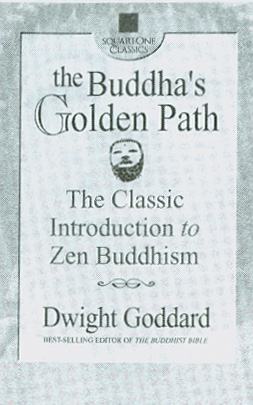 The Buddha’s Golden Path: The Classic Introduction to Zen Buddhism
The Buddha’s Golden Path: The Classic Introduction to Zen Buddhism
Dwight Goddard
New York: Square One Publishers, 2002
198 pages; $14.95 (paper)
Most people know of Dwight Goddard solely on the basis of his landmark A Buddhist Bible (1938). But Goddard, one of the first Americans to interpret the dharma for an English-speaking audience, was not merely a one-hit wonder; his efforts to popularize Buddhism in the United States were wide and varied. As the recent reissue of Goddard’s The Buddha’s Golden Path (1930) reveals, his prolific writing served as an important link in the transmission of Buddhism to America.
Goddard’s own path took him from a career as a mechanical engineer to an active life as both a scholar of comparative religion and advocate of missionary reform (culminating in an aborted attempt at founding in America the itinerant Zen sangha that Jack Kerouac—who repeatedly thumbed through Goddard’s Bible—would only dream of). Goddard’s scientific mind, his proselytizing zeal, and his pragmatism inspired his efforts as a writer of articles, pamphlets, and mainly self-published books intended not for scholars but for laymen—the “very many sincere inquirers” who could not afford to study Buddhism in monasteries or even in universities. The Buddha’s Golden Path, intended to serve as a “simple but comprehensive . . . manual of practical Buddhism,” is best read as an attempt to devise a workable, nondogmatic, empirical system for transforming not only the self, but the world.The Buddha’s Golden Path serves both as Goddard’s first mature attempt at making Zen accessible to an American audience and as a milestone on his own journey into Buddhism’s heart.
The main flaw of the book is that it is not so much about Zen, at least not in any historical sense. Examples from the Buddha’s life, for instance, are freely interchanged and reinforced with quotations from biblical texts. When one considers that at this stage of his study of Buddhism, Goddard was himself new to Zen (he became a serious student around 1928, less than two years before The Golden Path was published), he may be excused for such liberties. He admits at the start that the book is his “interpretation” of Buddhism designed “to meet modern conditions” of life in a highly rationalistic, staunchly Christian, devoutly individualistic America that, following the cataclysm of the First World War and facing the worst economic depression it had ever known, needed to be disabused of its “wrong thinking” (a later phrase, but a theme pervading the body of Goddard’s work—it provides the very urgency that leads him to set foot on the Golden Path). A former Congregationalist minister and missionary, he is familiar with the mindset of his audience and uses tropes and terms that he and his public know well, to illuminate the steps of the Zen path. Goddard blazes the trail for his readers in “scientific,” “practical,” familiar terms—yet with just enough of the preacher’s flair for the dramatic—so they can see that:
The new Path is certainly reasonable, it seems to lead toward some good end, and it carries with it a radiant promise of light and peace. Faith, hope and courage smilingly waiting to go with one. Resolution says, YES. LO! the external world seems evanescent, its importance fades into shadow, and ahead and inward the pathway clears and the difficulties fade away. It is the beginning of a new life process, a new venture spiritward full of promise and blissful peace.
Goddard’s unique contribution to the study of Buddhism in America, which echoes the Transcendentalist faith in self-cultivation and prefigures the Beats, is that he sets it forth not as a religion or even a philosophy, but as an “adventure.” “Buddhism is, first of all and last of all, an experience that each must interpret for himself,” Goddard tells us.
The path no longer leads onward and outward and upward, but inward . . . It calls and beckons us to follow, not from here to yonder, but just here, to explore and adventure here. . . .
In Goddard’s view, Buddhism is both the road one must explore to attain enlightenment and the map that shows the way. “Our guide is still the Golden Path . . . How are we to go? Why just trust it to guide us, that’s all.”
Whether his guidebook is, as the new subtitle broadcasts, a “classic introduction to Zen Buddhism,” is debatable. A student happening to thumb through it in a bookstore in search of a thorough study of Buddhist thought would be disappointed. But anyone wishing to learn more about the place that Buddhism could have in American life, whether in Goddard’s interwar America or today’s anxious post-9/11 world, should read this book. Goddard tells us that proper thought leads to proper action, and that one’s experience of Buddhism is the key to living it: no wonder he fits in well with Thoreau and company, or that Kerouac revered him so.
Thank you for subscribing to Tricycle! As a nonprofit, we depend on readers like you to keep Buddhist teachings and practices widely available.